Are tiny bugs buzzing around your fresh produce and kitchen counters? You might be dealing with food flies, also commonly known as fruit flies! These persistent pests are a common household nuisance, but thankfully, eliminating them doesn’t require expensive solutions or harsh chemicals. You can likely find everything you need to create effective traps right in your kitchen.
Like many households, we recently experienced a fruit fly invasion – a first in our home after several years! This unexpected occurrence became an opportunity to rigorously test various methods for getting rid of these annoying insects. Through careful observation and a bit of experimentation, we’ve identified the most effective DIY fruit fly traps and want to share our findings with you.
These homemade traps are incredibly easy to assemble using natural, everyday ingredients you probably already have. They offer a budget-friendly and chemical-free approach to pest control. For those who prefer a humane approach, these traps can also be used to capture and release fruit flies outdoors. Beyond traps, we’ll also provide essential tips for preventing fruit fly infestations in the first place, helping you maintain a pest-free kitchen.
Understanding Food Flies
Food flies, or fruit flies, are small, winged insects drawn to ripe and fermenting fruits and vegetables – hence their name. They are also attracted to sugary substances and fermented drinks like beer, wine, and juice. You’ll often find them congregating around fruit bowls, garbage disposals, compost bins, and even sink drains. They are tiny, about the size of a grain of rice, and resemble small houseflies with a tan or brownish color and distinctive red eyes. Food flies are most prevalent during the warmer months of summer and late fall when fruits are abundant and readily available.
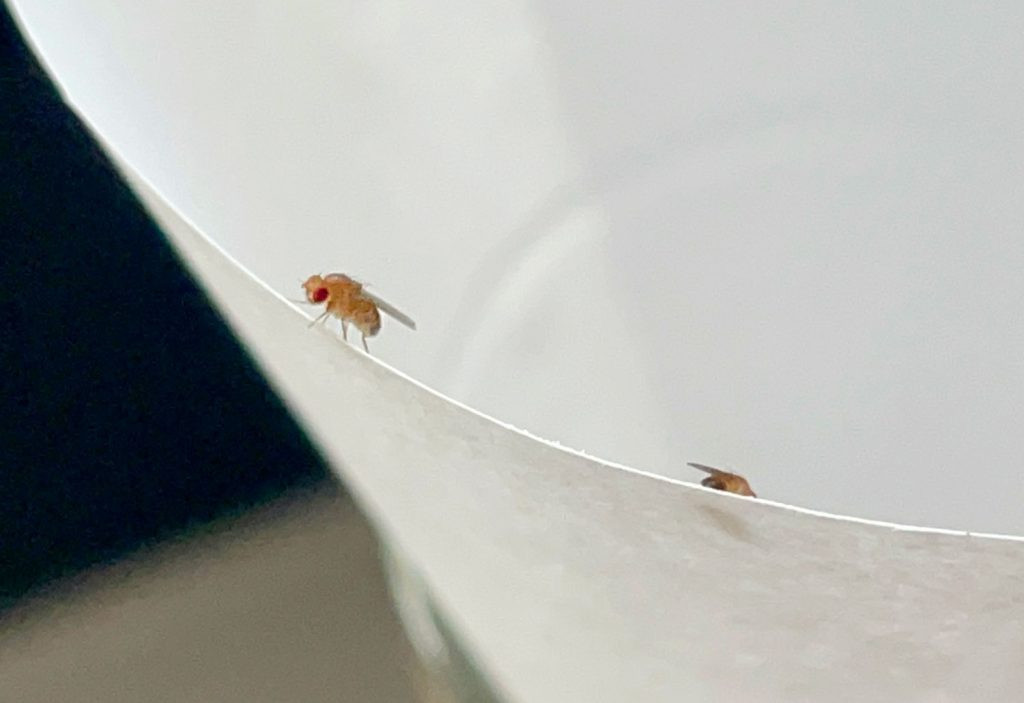 Close Up Of Fruit Fly On Paper Funnel
Close Up Of Fruit Fly On Paper Funnel
A fruit fly infestation often begins when a few flies hitch a ride into your home on fruits or vegetables from the grocery store. However, female fruit flies are prolific breeders, capable of laying hundreds of eggs in their short lifespan, with eggs hatching in as little as 12 hours. These flies can mature into adults within a few days, meaning a small initial presence can quickly escalate into a significant swarm. Prompt action is crucial to get rid of food flies and prevent a full-blown infestation.
Identifying Your Kitchen Pests: Food Flies vs. Fungus Gnats vs. Drain Flies
It’s easy to mistake food flies for other small flying insects commonly found indoors, particularly fungus gnats and drain flies. While all are small and fly, accurate identification is key to choosing the most effective elimination method. The easiest way to differentiate them is by observing where you see them and their physical resemblance to larger insects.
- Food Flies: Resemble small, typical flies. They are typically found hovering around fruit bowls, trash cans, spilled food, and other sources of fermenting food.
- Drain Flies: Look like small, fuzzy moths. As their name suggests, they are most often seen near sinks, drains, and damp areas.
- Fungus Gnats: Appear similar to small mosquitos. They are usually found near houseplants, as they breed in moist potting soil.
If you are uncertain about the type of fly you’re dealing with, try one of the traps described below. If it attracts the pests in your home, you’re likely dealing with food flies!
4 Simple DIY Food Fly Traps That Really Work
Eliminating food flies doesn’t have to be a complicated or expensive endeavor. You likely have all the necessary supplies already in your home, and it just requires a little patience. Each effective trap operates on a simple principle: attract the food flies into a contained area and prevent their escape. We tested four different DIY methods and found a clear winner in terms of effectiveness. Since each method utilizes common household items, trying multiple traps simultaneously can be beneficial. Consider yourself a food fly scientist – it can be surprisingly engaging! Here are four easy-to-make trap methods we tested:
- Funnel Trap
- Plastic Wrap Trap
- Dish Soap Trap
- Rotting Fruit Trap
Below, we’ll detail each method, providing step-by-step instructions and our assessment of their effectiveness. Keep in mind that some traps work faster than others, and complete eradication may take several days, regardless of the technique used.
Method 1: The Classic Paper Funnel Food Fly Trap
This trap design lures food flies into a container through a narrow opening at the bottom of a paper funnel. The flies are attracted by the bait inside but struggle to navigate back out through the small funnel opening.
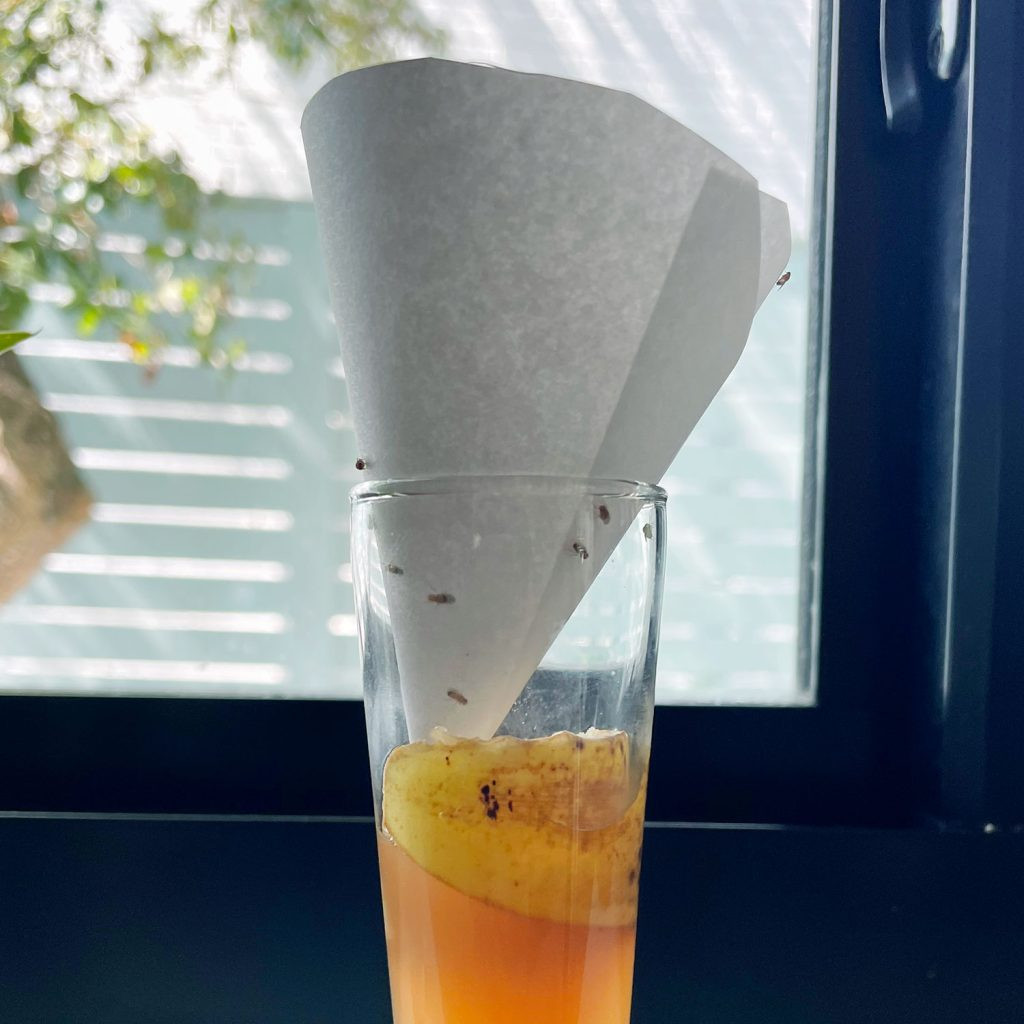 DIY Fruit Fly Trap With Paper Funnel
DIY Fruit Fly Trap With Paper Funnel
Supplies you’ll need:
- Small, clear jar, cup, or container – a narrow opening is preferable
- Sheet of paper or cardstock
- Tape
- Scissors
- Apple cider vinegar (ACV)
Step-by-step instructions:
- Choose your container: Select a small, preferably clear container like a recycled glass jar or plastic bottle. For this method, containers with smaller openings are more effective.
- Add the attractant: Pour a small amount of apple cider vinegar, old beer, or wine into the bottom of the container. The enticing scent will draw the food flies in.
- Create the paper funnel: Roll a piece of paper or cardstock into a cone shape with a very tiny opening at the pointed end. Secure the cone shape with tape. You can also cut the small opening at the tip after forming the cone. The opening only needs to be about the size of a grain of rice.
- Assemble the trap: Place the paper funnel into the opening of your container, with the narrow tip pointing down. You might need to adjust the funnel’s shape so it sits securely on the container’s rim without touching the liquid bait. Ensure the funnel fits snugly against the container’s edges to prevent flies from escaping through gaps.
- Humane removal option (optional): To release captured flies outdoors, carefully carry the entire trap outside, being careful not to disturb the funnel (or flies may escape). Once outside, remove the funnel to allow the flies to fly away.
While you can use a store-bought funnel, the opening at the bottom might be too wide, allowing more flies to escape than a homemade paper funnel with a very small opening.
Method 2: The Simple Plastic Wrap Food Fly Trap
Similar to the funnel trap, the plastic wrap trap uses the alluring scent of apple cider vinegar to attract food flies. They enter the trap through tiny holes poked in the plastic wrap covering the container’s opening but then find it difficult to exit.
Supplies you’ll need:
- Small, clear jar, cup, or container
- Rubber band
- Plastic wrap or a plastic bag
- Toothpick
- Apple cider vinegar (ACV)
Step-by-step instructions:
- Choose your container: Select a small, clear jar, cup, or any similar container. Clarity helps in monitoring trap effectiveness, but even an old can will work.
- Add the attractant: Pour apple cider vinegar into the container. Its scent is highly attractive to food flies. Old beer or wine can also be used, but avoid regular white vinegar, which is less effective.
- Cover the opening: Tightly stretch plastic wrap over the container’s opening and secure it firmly with a rubber band to create an airtight seal. You can use standard plastic wrap or cut a piece from a plastic food storage bag.
- Poke entrance holes: Use a toothpick to carefully poke a few small holes in the plastic wrap surface. A few small holes are sufficient, just large enough for a food fly to squeeze through.
- Humane removal option (optional): To release captured flies outdoors, carefully transport the trap outside without removing the plastic wrap (to prevent escape). Once outside, remove the plastic wrap to free the flies.
Alternatively, you can adapt this method using a jar with a metal lid. Puncture a small hole in the metal lid using a hammer and nail instead of using plastic wrap. Mason jars or recycled food jars with metal lids work well for this variation.
Method 3: The Easy Dish Soap Food Fly Trap
Unlike the previous two traps, the dish soap trap doesn’t require a cover. Instead, it relies on the reduced surface tension created by dish soap in the liquid bait to trap the flies. Note: This method is not designed for humane release as the soap affects the flies.
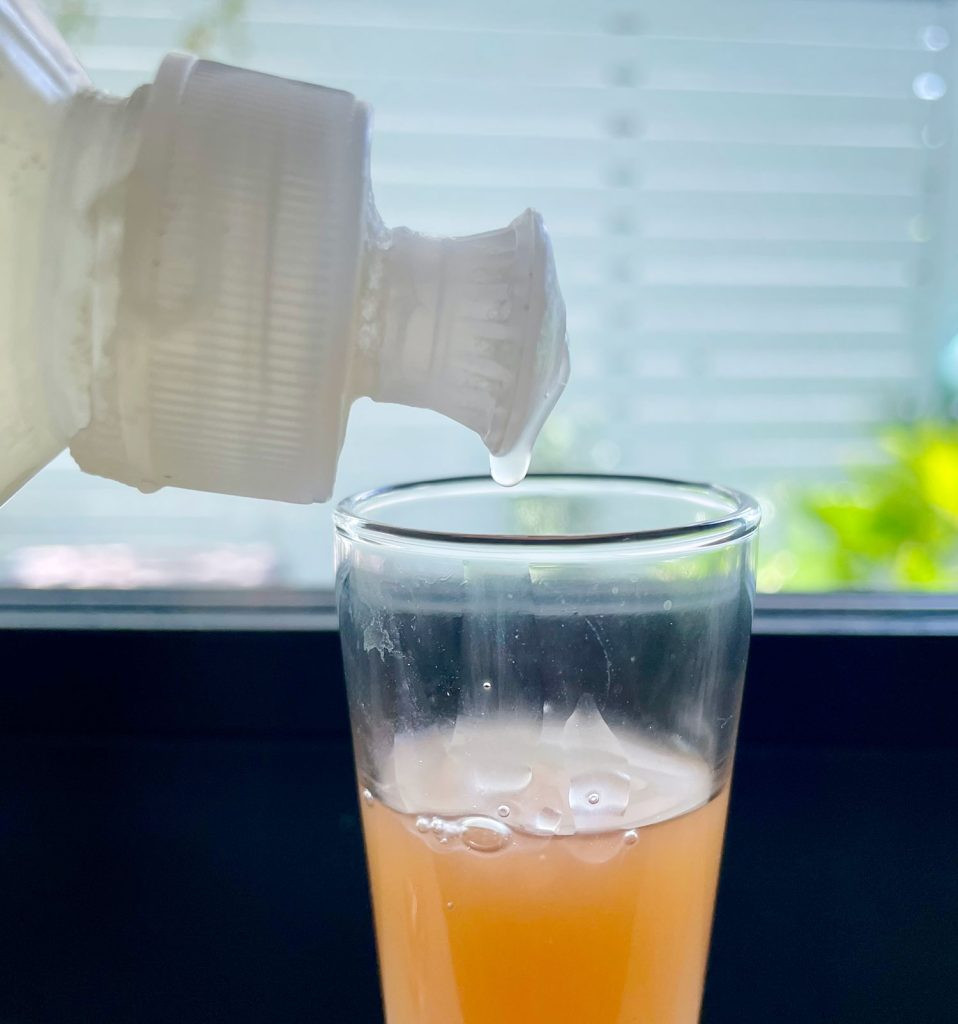 Dripping Dish Soap Into Apple Cider Vinegar For DIY Fruit Fly Trap
Dripping Dish Soap Into Apple Cider Vinegar For DIY Fruit Fly Trap
Supplies you’ll need:
- Small container, bowl, or dish
- Dish soap
- Apple cider vinegar (ACV)
Step-by-step instructions:
- Prepare the bait: Pour apple cider vinegar into the bottom of a small container, bowl, or dish. The scent will attract the food flies.
- Add dish soap: Add several drops of dish soap to the apple cider vinegar.
- Mix gently: Gently stir the dish soap into the vinegar to create a soapy solution. The soap reduces the surface tension of the vinegar, causing flies that land on the surface to become trapped and sink.
This dish soap technique can also be combined with the plastic wrap or funnel trap methods. Simply add dish soap to the apple cider vinegar before covering the container with plastic wrap or inserting the paper funnel. This adds an extra trapping mechanism to those designs.
Method 4: The Rotting Fruit Food Fly Trap
For this method, we experimented with swapping out apple cider vinegar for what food flies naturally crave: actual fruit!
Supplies you’ll need:
- Small jar, cup, or container
- Plastic wrap or paper funnel, depending on your chosen trap style
- A small piece of ripe or overripe fruit, such as a banana peel or apple slice
Step-by-step instructions:
To create a rotting fruit trap, simply replace the apple cider vinegar with a piece of ripe banana peel, apple slice, or peach in either the Plastic Wrap Trap or Funnel Trap setup. You can also enhance the apple cider vinegar traps by adding a piece of fruit as extra bait. However, be prepared to replace the fruit every day or two to prevent unpleasant odors in your kitchen as the fruit continues to ripen and decay.
Determining the Best Food Fly Trap Method
As shown in the images, we tested four different DIY trap combinations to evaluate their performance. The homemade traps we tested were variations combining different techniques and baits:
- Plastic Wrap Trap with banana peel
- Funnel Trap with ACV + banana peel
- Plastic Wrap Trap with ACV + dish soap
- Dish Soap Trap with ACV
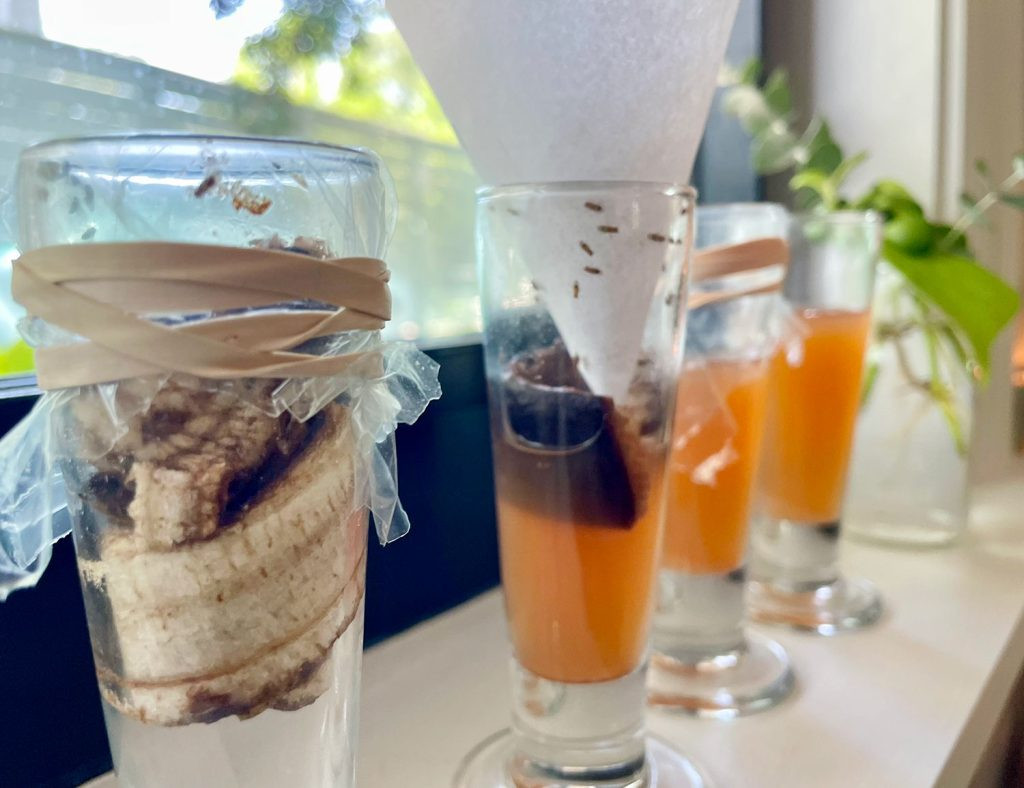 4 DIY Fruit Fly Traps Close Up
4 DIY Fruit Fly Traps Close Up
Our results indicated that the type of bait was a more significant factor than the trap design itself. Traps using banana peel as bait consistently outperformed those using only apple cider vinegar. Our two Plastic Wrap Traps were virtually identical in construction, yet the one baited with banana peel captured significantly more flies than the one using ACV and soap. Perhaps apple cider vinegar is less appealing when real fruit is present?
Based on our experiment, we recommend incorporating a piece of fruit into any food fly trap you set up. We found a slight preference for the plastic wrap trap due to its ease of construction and stability – we accidentally tipped over the funnel trap once, releasing some captured flies back into the kitchen!
What Bait Attracts Food Flies the Most?
Intrigued by the success of fruit baits, we extended our experiment to determine which type of fruit is the most effective at attracting food flies. We tested three readily available fruits: banana peel, apple slices, and a strawberry. Each fruit was placed in a separate Plastic Wrap Trap and set out side-by-side on our counter for 24 hours.
While the banana peel initially seemed promising (as it was the ripest at the start), the strawberry ultimately attracted the most food flies. The banana peel still captured a good number of flies, but the strawberry’s attractiveness increased as it ripened further. Interestingly, the apple slices didn’t catch a single fly in this test!
Store-Bought Food Fly Trap Options
If DIY traps aren’t working for you, or if you prefer a ready-made solution, several effective store-bought fruit fly traps are available. These traps generally have excellent customer reviews and are typically priced under $20. They might be a worthwhile option if you want a trap that catches a broader range of flying insects or if you prefer a more discreet trap design compared to homemade versions.
 Collage of Storebought Fruit Fly Traps
Collage of Storebought Fruit Fly Traps
During our testing, we purchased a pack of Terro Fruit Fly Traps to compare their performance to our homemade traps. We placed a Terro trap alongside our banana and strawberry traps for 24 hours to compare their effectiveness.
Again, our homemade strawberry trap performed best, followed closely by the banana peel trap. The store-bought trap caught only a single fly during this initial 24-hour period. HOWEVER…
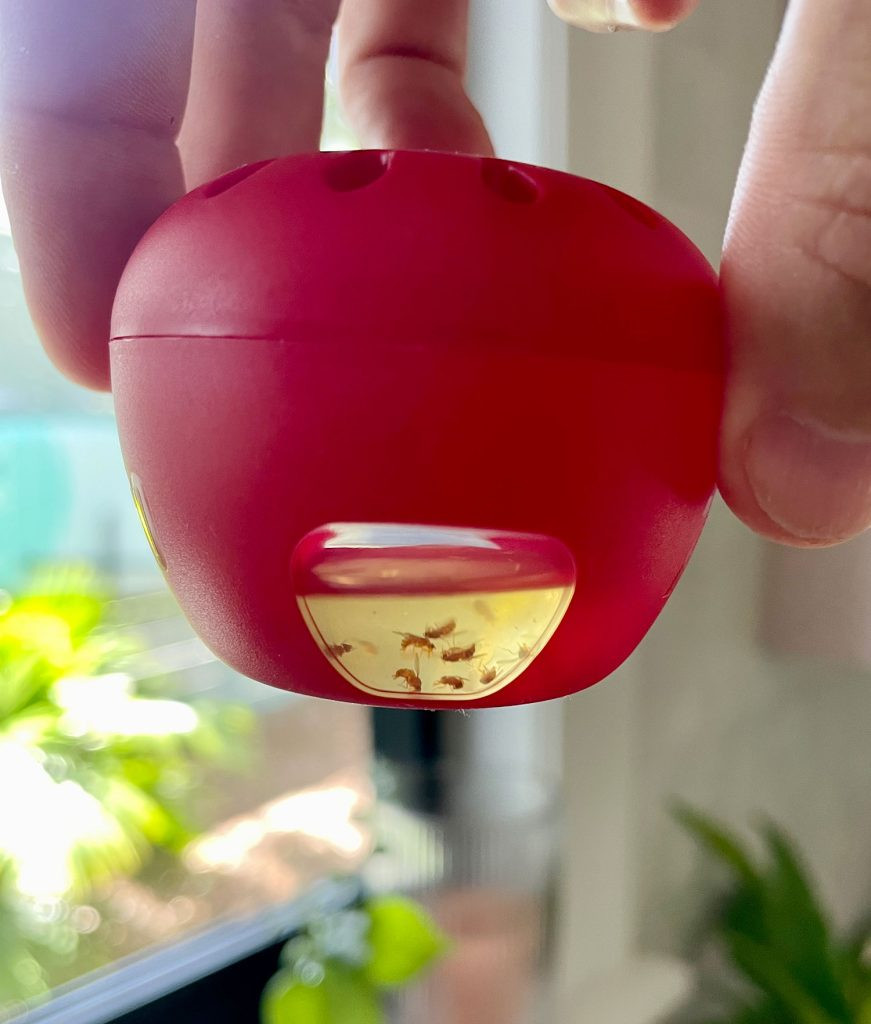 Terro Fruit Fly Trap With Dead Fruit Flies Visible
Terro Fruit Fly Trap With Dead Fruit Flies Visible
To ensure a fair comparison, we discarded our DIY traps and left the store-bought Terro trap out for another 24 hours. Over the subsequent day, it captured a significant number of flies, as shown above. So, store-bought traps are effective, just not as immediately or aggressively as our top-performing homemade traps. Our conclusion? Store-bought traps are a good option if you want a more inconspicuous trap, especially for longer-term placement. However, homemade traps are highly effective for quickly and efficiently getting rid of food flies right away!
Preventing Food Flies: Simple Steps to Keep Them Away
While getting rid of food flies is relatively straightforward, preventing them from infesting your home in the first place is the best approach. Here are simple preventative measures you can take to minimize the risk of food fly problems:
- Maintain clean kitchen surfaces: Regularly wipe down kitchen counters, stovetops, tables, and any surfaces that can accumulate food residue or liquid spills. Food flies are particularly attracted to fruit, sugary juices, and alcohol, so prompt cleanup is key!
- Dispose of trash promptly: Food scraps left in your garbage can overnight can quickly become a breeding ground for food flies. Empty your trash cans frequently, especially those in the kitchen.
- Manage ripe fruit: Regularly check your fruit bowl and discard overripe or rotting fruits like apples and bananas before they become a food fly magnet.
- Wash produce immediately: Washing fruits and vegetables as soon as you bring them home from the store can eliminate any fruit fly eggs or larvae that may be present on the surface. (Note: Berries may spoil faster if washed before storing, so wash them just before consumption).
- Refrigerate produce when possible: Food flies don’t thrive in cold temperatures, so storing fruits and vegetables in the refrigerator, when appropriate, can deter infestations.
- Clean sink drains regularly: Food particles trapped in your sink drain can attract food flies. Use your garbage disposal regularly and flush drains with hot water or a drain cleaner periodically.
Finally, don’t panic if you spot food flies in your home. While you should act quickly to prevent the problem from worsening, the DIY and preventative solutions outlined here are easy, effective, and fast-acting. You might even find a bit of fun in becoming a food fly scientist, just like we did!
*This post contains affiliate links, so we may earn a small commission when you make a purchase through links on our site at no additional cost to you.*